IKEA is an international corporation that primarily operates in the retail furniture sector. At present, it is one of the most notable companies in the world, ranking #40 among the most valuable brands on the Forbes list and employing more than 200,000 workers (Forbes, 2021). At the same time, the company ranks #21 among the best employers globally, implying sustainable management practices and attention to employees’ needs (Forbes, 2021).
The company has a rich history – it was established in 1943 in Sweden and named as an abbreviation after Ingvar Kamprad from Elmtaryd Agunnaryd (‘Snapshots’, 2021). From that point on, the company rapidly developed by increasing the number of retail stores, opening restaurants, applying innovative manufacturing approaches, and establishing an international presence (‘Snapshots’, 2021). Currently, the organisation has more than 450 retail stores around the world, which is demonstrated below in Figure 1:
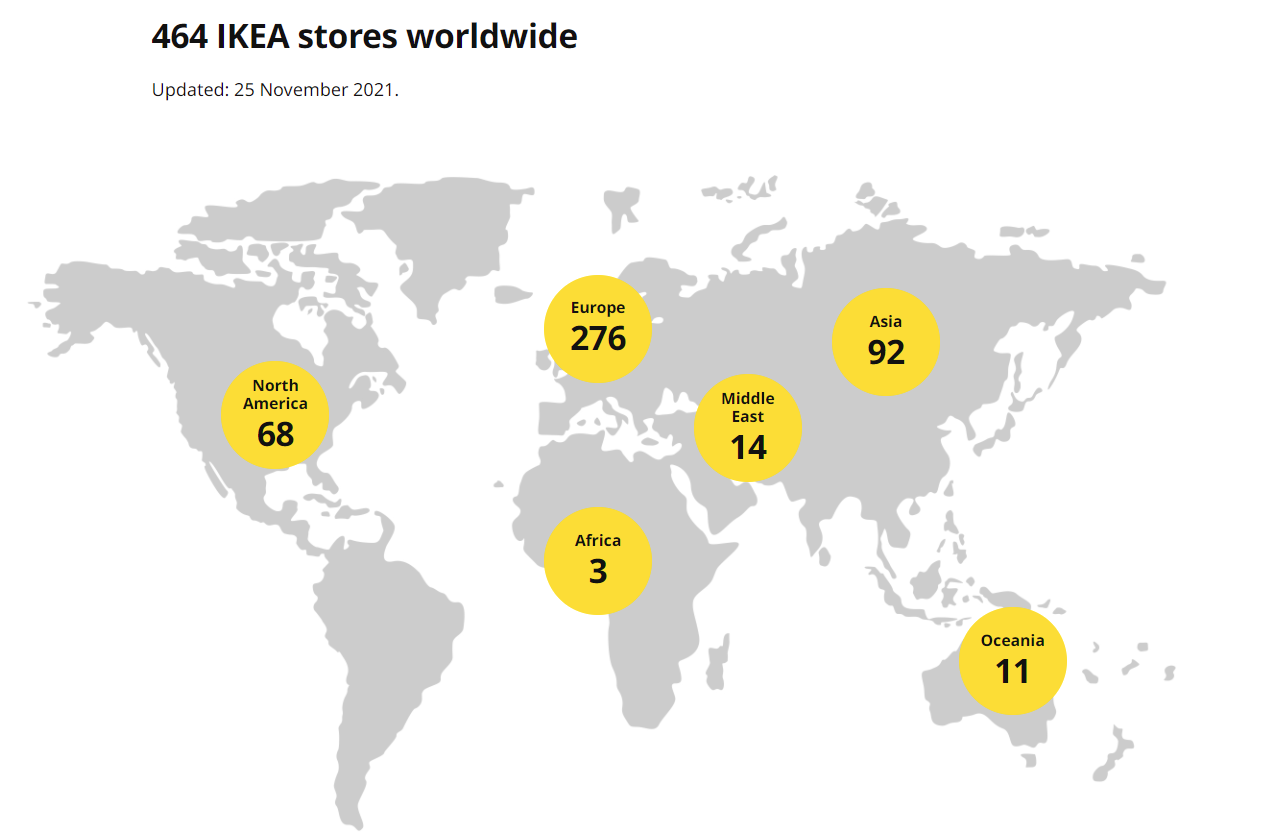
Ultimately, IKEA is one of the most notable companies in the retail furniture industry and might become even more relevant in upcoming years. The current paper conducts a thorough analysis of IKEA from the perspective of organisational management and human relations approach.
Organisational Structure of IKEA
At present, the organisational structure of IKEA consists of a large number of subsidiaries, franchises, and properties. Inter IKEA Holding B. V. is the parental company, which cooperates with franchisees and suppliers; the structure is demonstrated below in Figure 2:
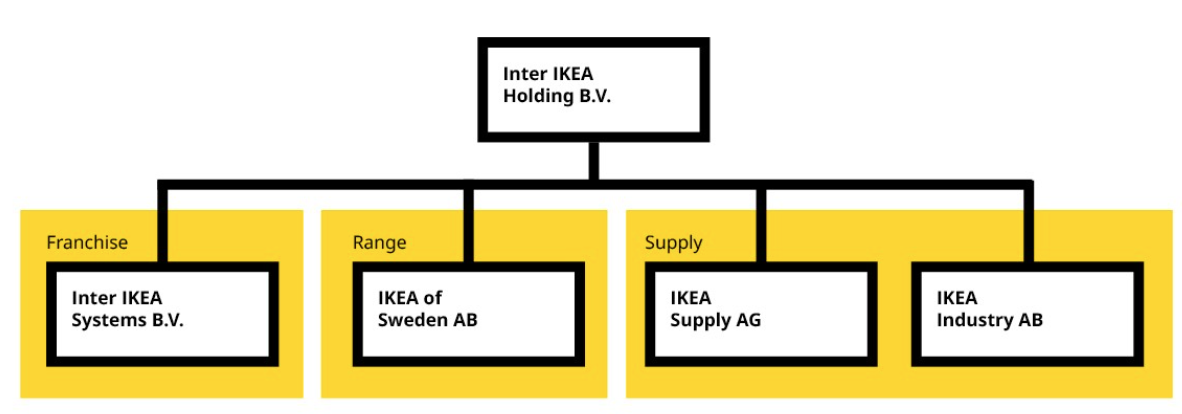
Thus, the IKEA brand is generally considered a franchise business, where Inter IKEA is the core company. Consequently, IKEA encompasses a large number of smaller organisations under the franchise name, which ensure the design, supplies, development, and distribution of all the product range (‘Our business in brief’, 2021). The chart demonstrating the franchise chain is presented below in Figure 3:
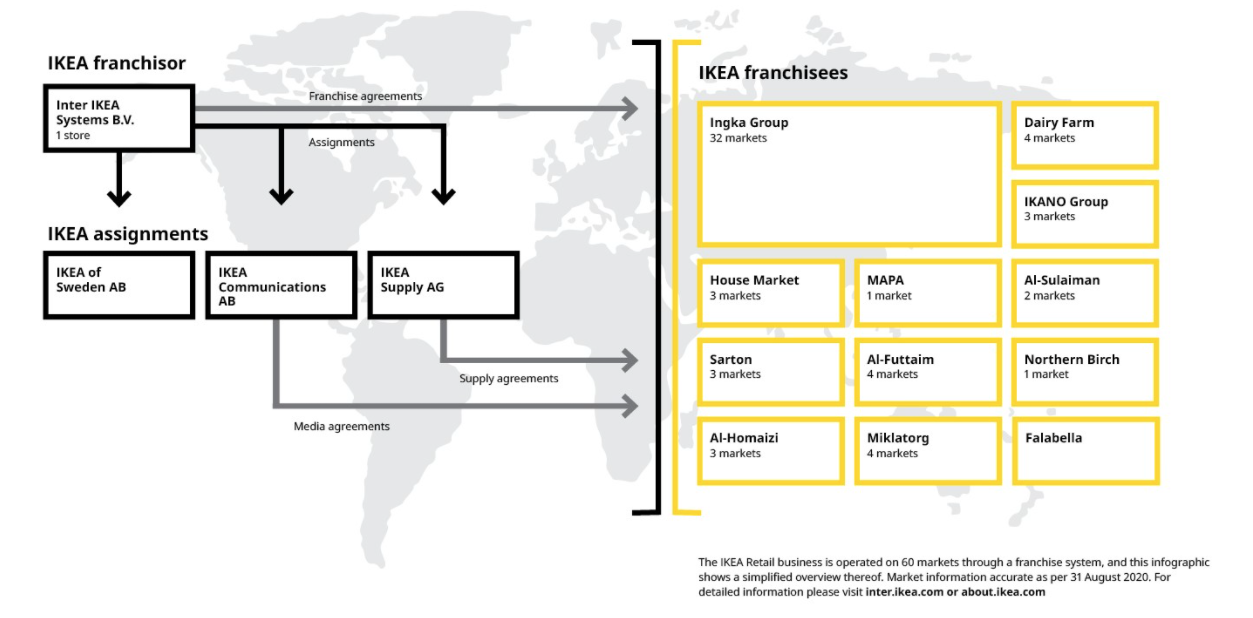
Concerning direct management, most of the power belongs to Jon Abrahamsson Ring, the CEO of Inter IKEA Holding, while the official owner company of Inter IKEA Group is a self-owned entity Interego Foundation (‘Management structure’, 2021). Ingvar Kamprad – the founder and the prior CEO of the company – died in 2018 at the age of 91. Nevertheless, the current management structure follows the conventional system implemented by Ingvar Kamprad and focuses on the cooperation between various suppliers, franchises, and subsidiary companies.
Values and Organisational Culture
The organisational culture of IKEA revolves around the humane aspect of business, thus, emphasising creativity and openness. Some of the company’s values are simplicity, enthusiasm, togetherness, zero tolerance towards corruption, and cost-consciousness (Inter IKEA Group, 2016). Furthermore, IKEA strives towards a better future and addresses sustainability issues, including climate change, social injustices, education, responsible sourcing, and supply chains (‘Sustainability’, 2021). The focus on fairness and equal opportunities creates a unique and productive organisational culture, where employees feel safe and confident in the future. In turn, it allows the workers to have maximum creativity and freedom in the work process. The company states, “We must all be proactive when it comes to protecting health and the working environment” (Inter IKEA Group, 2016, p. 9). Thus, IKEA implements the ethical, moral, and legal regulations at the workspace to mitigate any type of harassment or discrimination.
This approach is particularly notable in the design of furniture and the policy of cost-consciousness. The organisation transparently states that the prices of the products should be less than those of the competitors, and it is the only demand from the designers (Sin et al., 2021). Therefore, the designers can use any type of material, shape, colour, and other features as long as the production cost of the furniture fits the proposed standard.
This policy allows the company to maintain the minimum cost policy while allowing the suppliers and designers to have creative freedom. In turn, the said cost-efficiency is generally recognised as one of the primary competitive advantages of IKEA. The research by Sin et al. (2021) demonstrates that more than 60% of customers choose the company because of low-cost policies and the cost-quality ratio. Ultimately, the chosen approach allows IKEA to satisfy both customers and employees, which explains the stable growth of the company.
Summing up, the eight IKEA key values are (‘IKEA culture and values’, 2021):
- Lead by Example;
- Togetherness;
- Caring for People and Planet;
- Cost-Consciousness;
- Simplicity;
- Renew and Improve;
- Different with a Meaning or Creativity;
- Responsibility.
The Impact of Sustainability on Organisational Culture
Consequently, it is essential to discuss the role of sustainability in more depth due to the vast influence of the approach on the organisational culture. As mentioned before, sustainability concerns the social, environmental, and economic factors, allowing for better organisational culture and productive workspace conditions. Laurin and Fantazy (2017) demonstrate that sustainability is one of the most significant factors that support the company’s growth. Figure 4 below shows the overall impact of sustainability on strategies, organisational culture, risk management, and transparency:
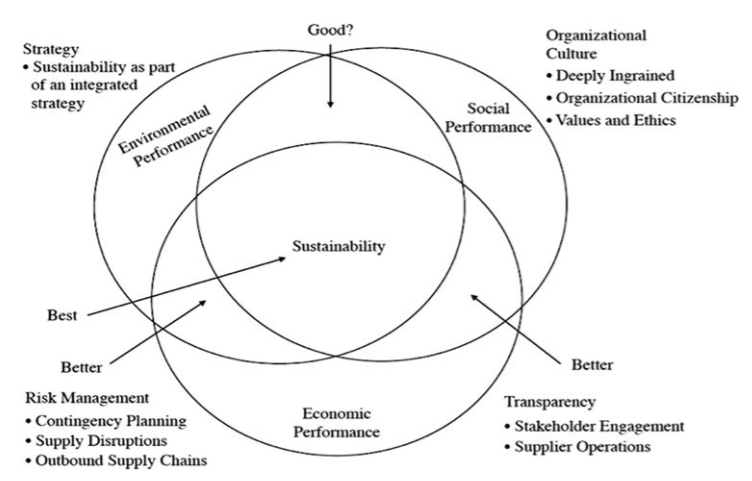
As seen from the chart, sustainability plays a vital role in organisational culture and prioritises social values. Furthermore, IKEA’s mission ‘create a better everyday life for many people’ aligns with sustainable efforts and also has a positive impact on the corporate culture (Laurin and Fantazy, 2017). Despite the global presence and more than 200,000 workers, the company focuses on employees first to guarantee that everyone is content with the working conditions and does not feel discriminated against (‘Fair and equal’, 2021). Concerning the issue, the organisation states, “For us it’s about giving everyone a voice and putting people first’ (‘Fair and equal’, 2021). This approach transparently explains why IKEA is one of the best employers in the world according to international rankings.
Human Relations Approach
Having discussed the underlying principles of organisational culture in IKEA, it is critical to analyse it from the management perspective. Human resources constitute an essential part of every organisation and are vital to the overall development of the company. From these considerations, a large number of management theories revolve around human creativity, transformational leadership frameworks, and focus on people. Ultimately, the Human Relations Theory of Management is one of the most notable models that emphasise the humane aspect of work and prioritise the well-being of the employees (Ward, 2021).
The core concept of the theory is that positive social bonds and a healthy workspace environment significantly enhance the productivity of the team (Ward, 2021). The employees are perceived as individuals with unique motivations, objectives, strengths, weaknesses, and perspectives. This approach closely resembles the IKEA management model with the vast emphasis on employees’ creativity and a safe environment. Ultimately, it is essential to briefly describe the principles of the model and demonstrate how they are applied in IKEA management.
Principles of Human Relations Theory
The Human Relations Theory of Management is interconnected with such concepts as the Hawthorne studies, Maslow’s Hierarchy of Needs, and Theories X and Y. These frameworks demonstrate the utmost significance of positive motivation in the work process. In other words, most people are more productive when they feel protected, understood, and authorised with creative freedom (Ward, 2021). For instance, the Hawthorne studies by Elton Mayo imply that non-economic incentives might significantly enhance the motivation and productivity of the employees (Bruce and Nyland, 2011).
It was a major breakthrough in social studies and organisational management, which had a vast impact on global corporations and their business models (Bruce and Nyland, 2011). These findings opposed the conventional model of tangible rewards, such as the scientific management theory, and claimed that intangible rewards, including a healthy workspace environment, were important factors as well (Bruce and Nyland, 2011). As a result, the Hawthorne studies paved the way for the contemporary Human Relations Theory.
Maslow’s Hierarchy of Need
Another critical concept to the Human Relations Theory is Maslow’s Hierarchy of Needs. It is a framework that represents the people’s needs and classifies their importance; the model is demonstrated below in Figure 5 (Adebayo, 2019):
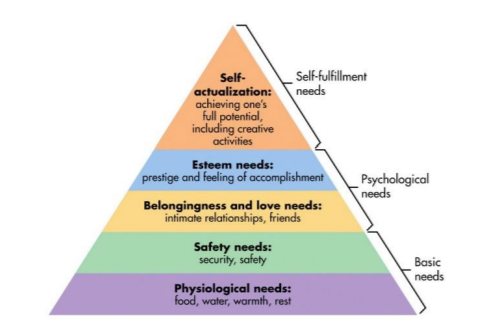
Concerning the Human Relations Theory, the chart implies that the motivation of employees grows accordingly as their needs are fulfilled. In other words, a worker with fulfilled physiological needs only is less productive than an employee who has both basic and psychological needs fulfilled. It is a core concept of the Human Relations Theory, which states that the company should address the self-actualisation, esteem, and belongingness needs of the workers to increase the productivity of the team (Adebayo, 2019). Consequently, there is an extensive amount of research that proves the efficiency of the framework. For instance, Stefan et al. (2020) demonstrate that the employees in the Romanian healthcare system perceive self-actualisation as the primary objective of their career. It implies that Maslow’s Hierarchy of Needs and the Human Relations Theory correctly predict the motivation of the employees, and intangible rewards are vital to productivity.
Consequently, it is apparent that the IKEA management model follows the underlying principles of the Human Relations Theory and Maslow’s Hierarchy of Need. The company transparently states that every employee should feel protected and provided with opportunities for career growth and self-actualisation (Inter IKEA Group, 2016). As mentioned briefly before, the motivation of employees increases according to the level of needs, with self-fulfilment needs being most difficult to achieve.
The HR department of IKEA makes its best efforts to retain employees by appealing to this factor and providing workers with possibilities for development and maintaining a positive atmosphere at the workspace (‘Work at IKEA’, 2021). Therefore, IKEA addresses the self-actualisation level of needs according to Maslow’s Hierarchy of Needs.
Furthermore, IKEA sets high standards of social sustainability, including inclusive culture, lack of racial and gender discrimination, and creative freedom. Therefore, IKEA appropriately addresses the psychological and safety needs of the employees, allowing for more productive operations. Furthermore, the company takes cultural differences into account; thus, it creates the workspace based on the internal organisational culture but also adjusts to the host country (‘Work at IKEA’, 2021).
For instance, the employees of the Indian department – a culture very different from European customs – have highly positive experiences working at the company despite the expected cultural barriers (‘Work at IKEA’, 2021). On the website, Sunitha – one of the employees – states, “Working at IKEA feels like home, like family” (‘Work at IKEA’, 2021). Concerning gender discrimination, she also mentions, “Irrespective of gender or qualifications, we are all treated fairly here” (‘Work at IKEA’, 2021). Ultimately, IKEA presents favourable workspace conditions for all employees, which aligns with the Human Relations Theory and Maslow’s Hierarchy of Needs.
Theory X and Theory Y
Another concept that significantly affects the Human Relations Theory is Theory X and Theory Y. The former suggests that employees need to be controlled for maximum productivity, while the latter assumes that employees do their work responsibly if provided with good working conditions (Adebayo, 2019). The research demonstrates that both approaches might be relevant depending on the industry and organisational culture (Tahir and Iraqi, 2018).
Nevertheless, based on the previous analysis, it is apparent that IKEA implements Theory Y in the workspace. The company perceives employees as individuals with unique motivation and grants them creative freedom and independence to some extent (Inter IKEA Group, 2016). At the same time, everyone has equal opportunities and is encouraged to utilise innovative approaches to make operations more productive (Inter IKEA Group, 2016). Thus, IKEA falls into the group of companies that implement Theory Y to their advantage and motivate the workers (Tahir and Iraqi, 2018). Ultimately, the analysis has demonstrated that IKEA applies the principles of the Human Relations Theory, Maslow’s Hierarchy of Needs, and Theory Y in their organisational management.
Scientific Management Theory
One of the opposing theories of the Human Relations Theory is the scientific management theory. In general, this framework implies total visibility of the process, supervision, control of operations, and maximum productivity (Dalcher, 2017). The founder of the theory – Fredrick Winslow Taylor – insisted that scientific methods of productivity determination are the most effective tools to improve performance (Dalcher, 2017).
In other words, the individual objectives, ambitions, and initiatives should be ignored, while focusing on control and predetermined actions (Dalcher, 2017). The underlying principle of the theory is transparently reflected by the words of the founder, “All we want of them is to obey the orders we give them, do what we say, and do it quick” (Dalcher, 2017, p. 4). This concept is still prevalent in a large number of companies, specifically, which require low-skill labour, such as the fast-food industry. Ultimately, this theory might be effective in certain cases; however, it is a relatively poor strategy to retain employees.
In the case of IKEA, the concept of scientific management is poorly applicable. The executives of the company transparently mention that they value the autonomy of the employees and appreciate a creative approach to responsibilities (Inter IKEA Group, 2016).
The feedback from the workers supports this perspective and reflects the company’s policies (‘Work at IKEA’, 2021). In this sense, IKEA’s organisational culture directly contradicts the underlying principles of the scientific management theory and theory X. While it holds true for the primary IKEA departments, such as furniture design and management, some of the scientific management concepts might be applicable to other areas. For instance, logistics and manufacturing are generally more structured processes and require a considerable amount of control and established goals. Therefore, while the core values of IKEA contradict the underlying principles of the scientific management theory, some of its concepts might still be applicable to work processes.
Similarities and Differences between Human Relations and Scientific Management
The Human Relations Theory and scientific management theory have both similarities and differences. The comparable part is the overall objective of the methods, which is to increase the productivity of the organisation. However, the contrastable part is much more extensive, and there is a large number of differences between the two theories (Dalcher, 2017). The primary contrast is the freedom and autonomy of the employee’s actions. Scientific management theory makes every effort to take complete control over the workers’ operations, while the Human Relations Theory allows them to have a considerable degree of independence (Dalcher, 2017).
Thus, according to the Human Relation Theory, employees are individuals that are valuable members of the team and not just mere instruments of achieving the objective. They are protected and rewarded with intangible rewards, which, in turn, increases their creativity and productivity. Ultimately, the Human Relations Theory acknowledges the motives of individuals and caters to them accordingly.
Having reviewed the opposing models, it is apparent that IKEA implements an approach that resembles the Human Relations Theory. The company favours innovative approaches (which do not always show immediate results), prioritises a healthy and relaxed working culture, and grants creative freedom. All of these factors contradict the scientific management theory with an emphasis on total control and lack of independence. Therefore, IKEA is a comprehensive example of a sustainable company that practices the Human Relations Theory of organisational management.
Critique to IKEA Organisational Culture
Evidently, the conducted analysis demonstrates that the IKEA management model follows the Human Relations Theory and ensures that every employee is content with working conditions. Nevertheless, the objective reality is frequently different from what the company states and wants to achieve. Therefore, it is critical to discuss the various critiques of IKEA organisational culture and determine whether the employees actually feel protected and are content with the management framework. From these considerations, Landen and Riltoft (2018) conducted a series of interviews with current and former IKEA employees of a lower level and received highly positive feedback about the company.
Twenty semi-structured interviews revealed that the company supported all eight key values, and the respondents had a mostly positive experience in these aspects (Landen and Riltfot, 2018). The organisational culture was described as “family-like”, “easy-going”, “relaxed”, and “positive to innovation”, which transparently reflects the company’s mission (Landen and Riltfot, 2018, p. 24). Ultimately, most of the respondents agree that IKEA is an employer that cares about its workers and supports their ambitions.
Nevertheless, the study also revealed certain critiques to IKEA organisational management. For instance, while the reviews from employees in the furniture department were highly positive, restaurant and logistics workers noticed a certain level of neglect (Landen and Riltfot, 2018). In this sense, the company does not pay due attention to complementary departments and focuses on its primary operations, such as designing and manufacturing of furniture. In other words, according to the feedback, the company maintains the different levels of the Human Relations application, which might be considered as discrimination or lack of appropriate focus.
Additionally, IKEA is accused of corporate tax avoidance schemes, which, unfortunately, is a relatively common strategy for global corporations. The IKEA HQ is located in the Netherlands, and the European Commission initiated several investigations of tax avoidance based on Dutch legal entities (Gunn et al., 2020). While it is a legal activity that exploits tax regulations, tax avoidance has a negative impact on the organisational culture of the company.
The employees might feel the threat of unfair treatment due to the relatively immoral deeds of the organisation. Nevertheless, most big brands and global corporations utilise legal exploits to some extent, including tax avoidance, labour offshoring, and other methods to minimise costs. Thus, the application of the Human Relations Theory should be based on the attitude of the company toward the employees and not the profit maximisation. Ultimately, despite the global presence of IKEA, there are few negative rumours and connotations about it, and most sources indicate that IKEA is true to its values and supports its employees.
Conclusion
At present, IKEA – a designer and manufacturer of furniture – is one of the most notable brands, which has a global presence and approximately 200,000 employees. Nevertheless, despite the extensive size of the corporation, IKEA implements an approach that closely resembles the Human Relations Theory. The company ensures that every employee feels protected and is provided with opportunities for career growth and self-actualisation regardless of age, gender, and race.
The analysis has also demonstrated that most current and former employees have positive experiences working at the organisation. Consequently, the paper compared and contrasted the Human Relations and scientific management theories, indicating that IKEA follows the former approach. Lastly, some of the critiques to IKEA’s corporate culture include the accusations of tax avoidance and neglect for complementary departments. Nevertheless, despite the several drawbacks, IKEA is a sustainable company that follows the primary principles of the Human Relations Theory of Management.
Reference List
‘About us’ (2021). Web.
Adebayo, O. (2019) ‘Evaluate the influence of classical and human relations approaches in management today’ Management, 1(2), pp. 1-15.
Bruce, K. and Nyland, C. (2011) ‘Elton Mayo and the deification of human relations’ Organizational Studies, 32(3), pp. 383-405.
Dalcher, D. (2017) ‘What has Taylor ever done for us? Scientific and humane management reconsidered’ PM World Journal, 6(4), p. 1-11.
‘Fair and equal’ (2021). Web.
Forbes (2021) IKEA. Web.
Gunn, A. F. et al. (2020) ‘A methodology to measure the quality of tax avoidance case studies: Findings from the Netherlands’ Journal of International Accounting, Auditing and Taxation, 39.
Inter IKEA Group (2016) Inter IKEA Group code of conduct. Web.
Laurin, F. and Fantazy, K. (2017) ‘Sustainable supply chain management: A case study in IKEA’ Transnational Corporations Review, pp. 1-10.
‘Management structure’ (2021). Web.
‘Our business in brief’ (2021). Web.
Sin, L. G. et al. (2021) ‘A case study of the factors that affect consumer behaviour in IKEA’, Asia Pacific Journal of Management and Education (APJME), 4(2), pp. 20-28.
‘Snapshots. The history of the IKEA brand at a glance’ (2021). Web.
Stefan, C. P. et al. (2020) ‘Implications of Maslow’s Hierarchy of Needs theory on healthcare employees’ performance’ Transylvanian Review of Administrative Sciences, 59, pp. 124-143.
‘Sustainability’ (2021). Web.
Tahir, K. H. K. and Iraqi, K. M. (2018) ‘Employee performance and retention: A comparative analysis of Theory X, Y and Maslow’s Theory’ Journal of Management Sciences, 5(1), pp. 100-110.
‘The IKEA franchise system’ (2021). Web.
Ward, P. (2021) Human relations management theory: Summary, examples. Web.
‘Work at IKEA’ (2021). Web.